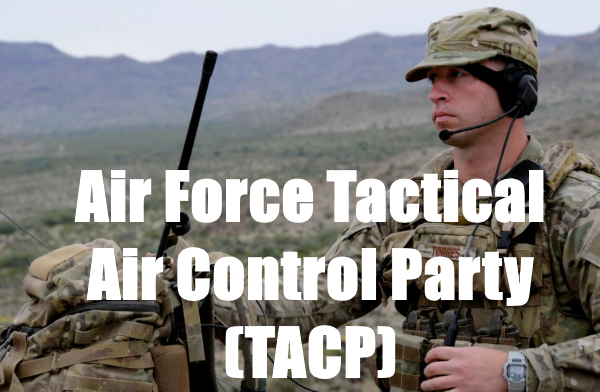Air Force Tactical Air Control Party (TACP) specialists embed with U.S. Army and Marine units throughout troubled spots in the world. It is the responsibility of the TACP (commonly pronounced as ‘TAC-P’) to call in an air strike on the right target at exactly the right time.
Air Force TACPs are members of Air Force Special Operations along with Combat Controller (CCT), Pararescue (PJ), and Special Reconnaissance (SR).
With the official motto “The strong shall stand, the weak will fall by the wayside,” TACPs are considered the ‘badasses’ of the Air Force.
Becoming an Air Force TACP is not for the faint of heart. The attrition rate of Air Force TACPs has been as high as 50% in recent years.
TACPs must undergo intense physical, mental, and technical training to prepare for the conditions of battle so that they can provide their team with the firepower necessary to ensure battlefield success.
Jump To A Section
Requirements and Qualifications
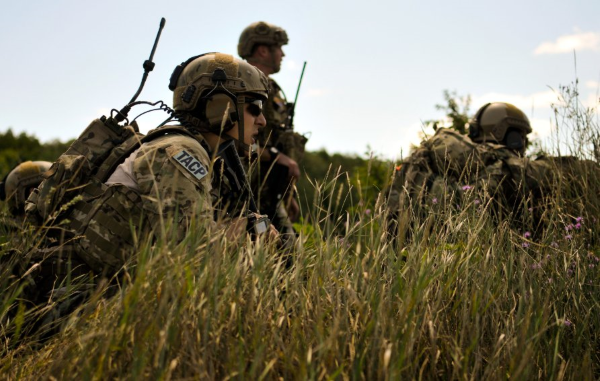
To become a TACP in the United States Air Force, there are specific requirements and qualifications one must meet, which include:
- High school diploma, GED with 15 college credits, or GED
- Successful completion of the USAF Special Warfare Operator Initial Fitness Test (IFT)
- A minimum score of 30 on the TACP selection model completed in the Tailored Adaptive Personality Assessment System (TAPAS)
- ASVAB score of at least G49
- Normal color vision and depth perception
- Compliance with medical standards for Ground Base Controller Duty
- Possession of a valid state driver’s license to operate government motor vehicles
- Must maintain the ability to deploy and mobilize worldwide
- Qualification to bear firearms
- Must be between the ages of 17 and 39
- Completion of a National Agency Check, Local Agency Checks, and Credit Check
- Completion of 7.5 weeks of Basic Military Training
Related Article – Air Force Grooming Standards: Haircuts, Mustaches, Beards, And More
Training and Career Path
Prior to becoming an Air Force TACP, you must successfully complete the Air Force Basic Military Training course, commonly referred to as “Basic.”
However, if you desire to be an Air Force TACP, the USAF recommends that you prepare prior to entering the TACP Pipeline.
To aid in that effort, the Air Force provides TACP candidates an easy-to-follow 21 Day Fitness Program for all Air Force candidates wishing to join the Air Force Special Ops.
They also have a 21-day program specifically designed for Special Forces candidates. You can download the PDF HERE.
Air Force Basic Military Training
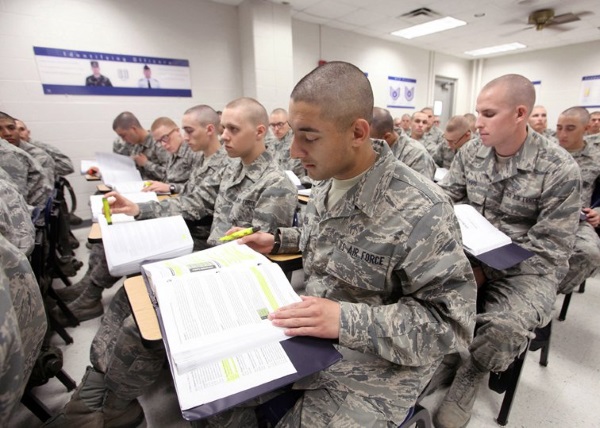
All airmen must attend Basic Military Training (BMT) at Joint Base San Antonio (JBSA) Lackland in San Antonio, Texas.
Related Article – How Hard Is Air Force Basic Training?
Air Force Basic Military Training is seven and a half weeks in duration. However, recruits enrolled in the Delayed Entry Program (DEP) gain an edge in preparing for Air Force boot camp by learning many of the military fundamentals with their Air Force recruiters.
Most recruiters also work with the fledgling recruits on preparing for the physical rigors they will encounter in Air Force Basic Military Training.
BMT Structure
The Air Force segments into weeks, from Week 1 to Week 7. Recruits, over time, have given each week a special nickname that best describes the week.
For example, Week One is commonly referred to as ‘Sneaker Week’ since recruits are not yet issued boots, and must wear tennis shoes with their uniforms, instead.
Week 6 is known as BEAST week for Basic Expeditionary Application Skills Training Week.
During BEAST Week, recruits prepare for mock deployment, live in tents, eat Meals Ready to Eat (MREs), and train for current combat environments.
Skills and fundamentals taught during the rigorous seven and a half weeks of Air Force Basic Military Training include:
- Physical Conditioning
- Basic Marching and Drill Movements
- Law of Armed Conflict
- Reporting and Saluting
- Temper Tent Training
- Mental Preparation for Combat
- Formal Retreat
- CPR Certification
- Code of Conduct
- Nuclear Biological and Chemical Training
- M9 (9MM) Pistol Training
- Military Citizenship
- Air Force History and Organization
- Combat Stress Recovery
- Joint Warfare
- Ethics
- Combat Stress Recovery
Please note that this list is but a basic overview of the skill taught during Basic Military Training and is not all-inclusive.
More detailed information about Air Force Basic Military Training is available here.
After Basic Military Training, the real work begins for Air Force TACP candidates.
Air Force Special Warfare Preparatory Course
The Air Force Special Warfare Preparatory Course is but the first leg in the long and arduous journey to become an Air Force TACP.
TACP candidates attend the Special Warfare Preparatory Course at JBSA Lackland.
Air Force Special Operations Training
The 7-week course challenges its students to undergo intense strength and conditioning training consisting of extensive swimming, running, and rucking. Air Force TACPs also learn about the armed services’ rich history of esprit de corps and Special Warfare.
Prior to continuing in the TACP Pipeline, candidates must take and pass the Initial Fitness Test (IFT).
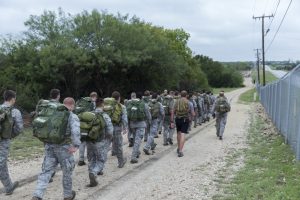
Air Force TACP Apprentice Course
Provided that they have made it this far in the Pipeline, TACP candidates attend Air Force TACP Apprentice Course, also known as the TACP Schoolhouse.
Based at JBSA Lackland, the TACP Apprentice Course is 21 weeks long and is where the highly specialized training happens for Special Warfare Airman.
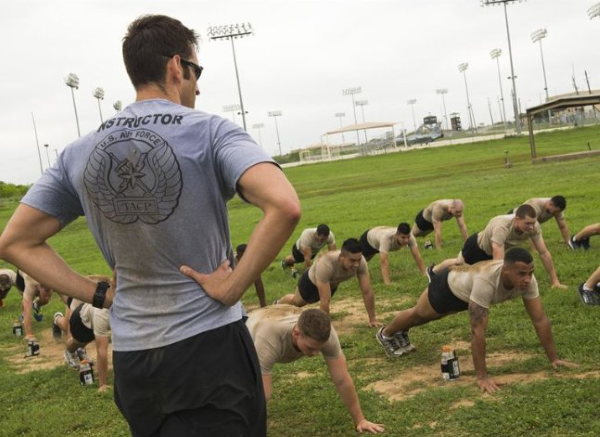
The TACP Apprentice Course provides the Air Force Special Warfare Airmen with instruction and assessment in the fundamentals, art, and science of small unit tactics, radio communications, and the basics of close-air support.
Army Basic Airborne School
As they will often embed with Army and Marine units, TACPs must get there with them. Sometimes this means ‘dropping in.’
Air Force TACPs train with soldiers at Army Airborne school for three weeks at Fort Moore, GA.
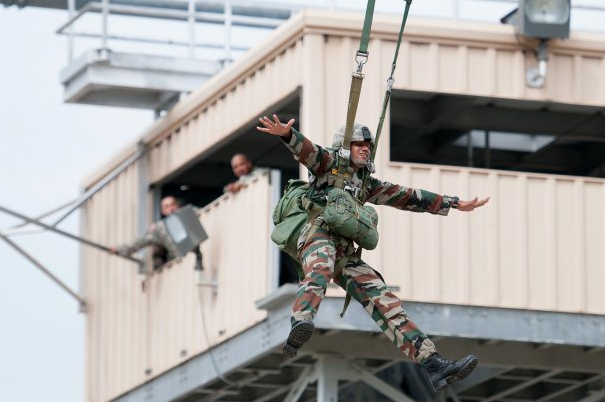
At Army Airborne school, Air Force TACPs learn basic parachuting and prepare for static line jump operations.
Related Article – Army Airborne School: Requirements, Length, Packing List, And More
Air Force Basic Survival School (SERE)
It’s on to Fairchild AFB, WA for our weary Special Warfare Airmen as they take on Air Force Basic Survival School.
The Basic Survival School, also known as SERE (Survival, Evasion, Resistance, and Escape) Training is three weeks long.
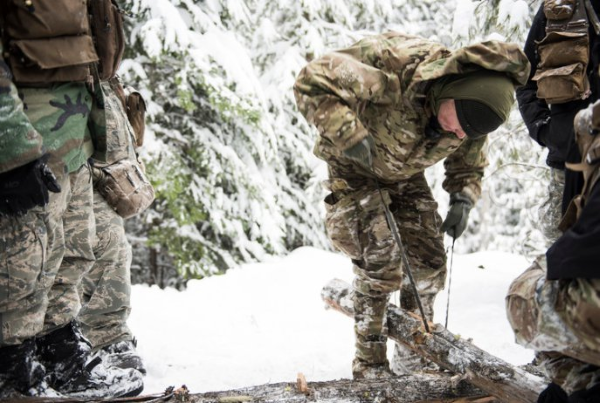
Survival on the battlefield and behind enemy lines is of paramount importance to the Special Warfare Airman. It is at SERE training that TACPs learn the survival, evasion, resistance, and escape training which may one day save their life and the lives of their fellow airmen, soldiers, and Marines.
Initial Certification Course: Phase 1 Combat Field Skills
Training for TACPs continues at Camp Bullis, Texas, to build on fundamental skills. This combat skills course is known as the “Ground Phase” of formal training for TACPs.
The 16-week course will teach TACPs what they need to succeed as a JTAC, Joint Terminal Attack Controller.
Skills honed include foot and vehicle navigation, radio operations, effective patrolling techniques, and small arms proficiency.
They also learn Tactical Combat Casualty Care in order to lend medical aid in the absence of medical corpsmen.
Initial Certification Course: Phase 2 Strike Phase
This 5-week course is a culmination of all the skills TACPs have learned thus far.
At Nellis AFB, Nevada, students will play out simulated, live Close Air Support mission scenarios. This is known as the “Air Phase” of formal TACP training.
TACPs learn the skills needed to call in precision air strikes needed on the front lines of battle.
Additional Training and Opportunities
Continued training is a part of life for the Air Force TACP. Below are additional training opportunities that TACPs may need to complete as they progress in their careers.
- Military Freefall Parachutist Course – 4 weeks – Yuma Proving Ground, Arizona
- Staticline Jumpmaster School – 3 weeks – Ft. Moore, Georgia
- Military Freefall Jumpmaster School – 3 weeks – Yuma Proving Ground, Arizona
- U.S. Army Pathfinder School – 3 weeks – Ft. Campbell, Kentucky
- U.S. Army Air Assault School – 2 weeks – Ft. Campbell, Kentucky
- U.S. Army Sniper School – 7 weeks – Ft. Moore, Georgia
- U.S. Army Ranger School – 62 Days, Ft. Moore, Georgia
- Combat Diver Qualification Course – 4 weeks – Key West, Florida
How Much Are Air Force TACP Paid?
Pay for an Air Force TACP is identical to all other enlisted personnel (in all branches), based on an airman’s rank and length of service.
| Rank | Monthly Pay (per month) |
|---|---|
| E-1 Airman Basic +4 months | $1,917 |
| E-2 Airman | $2,149 |
| E-3 Airman First Class | $2,259 |
| E-4 Senior Airman | $2,503 |
| E-5 Staff Sergeant | $2,730 |
| E-6 Technical Sergeant | $2,980 |
| E-7 Master Sergeant | $3,445 |
Air Force TACPs may also be entitled to other forms of compensation including basic allowance for housing (BAH), base allowance for subsistence (BAS), and other forms of compensation such as Battlefield Airmen Skill Incentive (BASIP) pay if eligible.
It’s important to note that Air Force TACPs are often eligible for sizeable enlistment and selective re-enlistment bonuses based on the current needs of the Air Force.
What’s Life Like as an Air Force TACP?
Life as an Air Force TACP is challenging but rewarding.
Special Operations Forces TACP
TACPs are often referred to as the “Air Force Infantry,” as they spend most of their career assigned to Army units, usually with special operation forces.
TACPs primary role is to direct combat strike aircraft against enemy targets. In support of this mission, Air Force TACPs often serve on the front line in advance of other military units.
TACPs are often confused with Combat Control Technicians (CCTs). They are not. Airman 1st Class James Blair describes the TACPs mission and the differences.
“Some people think we are air traffic controllers, but that’s inaccurate. Our mission is terminal control. That means bombs on target and a very bad day for the enemy. TACPs do not control aircraft like CCTs do. TACPs direct the bombs, artillery, and missiles on the enemy positions.”
Air Force TACPs are in constant states of deployment, boots on the ground, or training.
It is the boots of Air Force TACPs which dot the land of some of the most troubled, war-torn, inhospitable spots in the world. Their commitment to the fight for peace and freedom entitles them to be the only member of the United States Air Force to don the coveted black beret.
Civilian Career Opportunities
Due to the peculiar duties performed by Air Force TACP, civilian opportunities are limited. A search for TACP on www.clearancejobs.com yielded only 26 results. Civilian companies (mostly defense contractors) were seeking ASOS (Air Support Operations Squadron) Support personnel, JTAC instructors, Systems Engineer/TACP, Test Engineer, USAF EOD Instructor Support, Senior Systems Engineer, and Senior Program Manager.
While civilian career opportunities are limited, TACPs leaving the Air Force can use their security clearance (if active) to aid in their job search.
Ex-Air Force TACP gives advice on civilian life after TACP.
Because of the limited civilian career opportunities, TACPs are strongly encouraged to take full advantage of their Post 9/11 GI Bill and all education opportunities afforded them during their time on active duty, such as the Air Force Tuition Assistance program and CCAF (Community College of the Air Force).
Related Article – How To Get Into The Air Force Academy
If you are considering joining the Air Force and are not afraid to push yourself, a career as an Air Force TACP is certainly well worth consideration. You will not only travel the world and perform a vital service to your country, but you will also be among the most elite members of the United States Armed Services.
Another motto of the Air Force Tactical Air Control Party is “100% and then some!”
Do you have what it takes?
References
TACP Career Opportunities at www.clearancejobs.com
Air Force 21-Day Fitness Program
- Ikon Pass Military Discount: Learn How To Save Big - January 31, 2025
- RTIC Military Discount: Find Out How To Save Big on Gear - January 30, 2025
- Traeger Military Discount: Learn How To Save Big on Smokers - January 28, 2025

